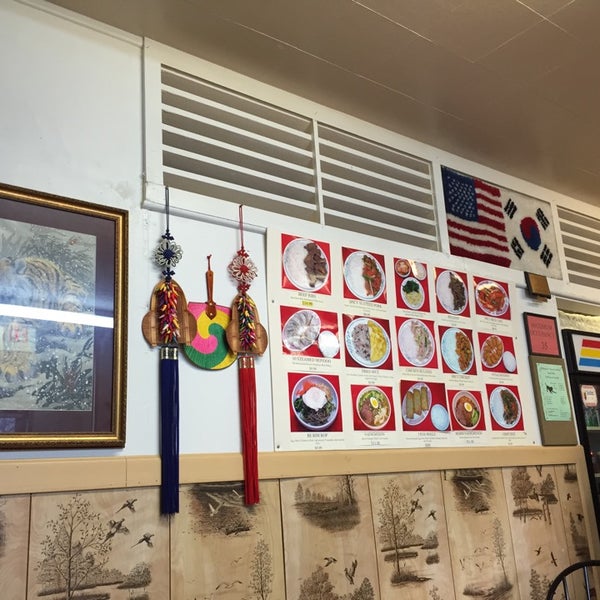Table Of Content

After a few drinks, tax, and tip, expect to pay around $60 a person, which is a solid deal these days. When people ask what the best Korean barbecue is in Los Angeles, most people will mention Park’s BBQ first. It’s hard to argue against over 20 years of excellence, with an energetic vibe inside and fantastic meat quality from start to finish. Chef and owner Jenee Kim does an amazing job with the non-meat dishes as well, like the delicious spicy braised black cod or the gochujang jjigae. Bringing a taste of the infamous, Michelin-recognized Myung Dong Kyoja from Seoul, MDK Noodles offers the same classics from the carb-laden menu, including knife-cut noodles with chicken, anchovy, or vegetable broth. Don’t skip on the pork dumplings, and for those who aren’t in the mood for something soupy, the cold noodles with skate are a refreshing option.
KTEAM BBQ
The live uni is another popular specialty item that is served in an urchin shell and paired with marinated rice and premium fish roe. A truly quirky restaurant that’s found a steady following on social media, Borit Gogae is a very rustic Korean experience that works as a contrast to the highly developed country and its technological advancements. With all of that progress, there’s a yearning both in Seoul and even here in Los Angeles for simple, country cooking and Borit Gogae nails the experience, from the dozen or so banchan, mixed barley rice, and soup. Bring a few friends and enjoy this bargain of a tasting menu served all at once, Korean-style.
Exceptional Korean Restaurants to Try in Los Angeles

Sulga House of Bone Soup is a Korean soup specialist worth celebrating, particularly with its reliable, rich brisket soup, which only uses organic beef and premium cuts ranging from ribeye to cow knee. The restaurant’s menu also exhibits an unexpected level of creativity, from the spicy corn acorn noodles sweetened by beets to the cold wild yam noodles and the bonnet bellflower root bibimbap. One of Koreatown’s most reliable barbecue spots, Yangmani has an expansive outdoor tented area for quality beef, pork, and offal cuts that younger diners tend to prefer in the neighborhood. Yangmani might be the best place if you want to take down bottles of beer and soju, and just have a good time with friends or coworkers.
Grilled Salmon
Best Korean Restaurant 2022 Food + Dining Orlando - Orlando Weekly
Best Korean Restaurant 2022 Food + Dining Orlando.
Posted: Wed, 31 Aug 2022 18:16:34 GMT [source]
The restaurants have big wooden beams and a bar with craft beers in their center. Mall landlords and analysts note it’s a big blow to lose any big-name anchor eatery. But Macy’s, JCPenney, Nordstrom and others are closing hundreds of their stores in malls as online shopping has grown to around 16% of US retail sales. Real estate research firm Green Street estimates about 150 enclosed malls have closed since 2008, leaving about 900 today. Experience our Assorted Tofu Soup that comes with beef, shrimp, and clam, served in a bubbling hot-stone pot.
Sulga House of Bone Soup
This is the premier Korean barbecue restaurant in Koreatown, and Park’s delivers with prime-grade meats served at the table, along with a slew of other traditional Korean dishes shared in a clean, smoke-free ambiance. The quality of the meat and banchan is simply unsurpassed, rivaling some of the best in Seoul itself. The front parking lot has been converted into an outdoor Korean barbecue setup for additional seating. A big chain in Asia, Magal BBQ continues to prepare some of the best mid-range Korean barbecue in town, featuring flavorful off-cuts and non-primal selections that still offer plenty in the way of flavor. In fact, the restaurant was the first in Koreatown to popularize de-shelled marinated crab bowls with crab sourced directly from Korea.
Now with two locations in Koreatown, Jinsol Gukbap has made a name for itself for its rich, flavorful Busan-style gukbap, or pork soup, which is made with a broth that is simmered for 24 hours. Though the gukbap is undoubtedly the star here, other favorites include the pork belly slices, served with a special soy-based sauce, kimchi stew with pork belly, and marinated spicy pork ribs. For those looking to venture outside of pork, you can’t go wrong with the spicy braised chicken with vegetables or the cold noodles. Seafood staple Soban can do no wrong, serving up an amazing array of banchan to begin each meal.
Chick-fil-A restaurants were only located in mall food courts for the company’s first 20 years. The amount of space dedicated to food in malls has grown from 5% in the 1990s to 15 to 20% today, according to Deloitte. Food was long an afterthought at malls, and department stores were the primary reason shoppers visited. There’s a new guard in malls,” said Chris Simms, the CEO and founder of Lazy Dog, which has around 50 ski lodge-themed restaurants around the country.
Say goodbye to Ruby Tuesday and Chili’s. These are the hot new restaurants at the mall
Strong restaurants and entertainment options draw steady food traffic and can increase the amount of time a consumer spends in the mall, making them valuable to landlords and other mall tenants. Over the last few decades, malls became the town center of many American communities. But the pandemic, over-building and a move by consumers toward discount and online shopping changed all that.
Opening Time
Enduring Korean barbecue specialist Yangmani treats intestines on the same level as primal cuts, and the crowds every night are evidence of the restaurant’s popularity. The restaurant, which has a second location in Rowland Heights, serves a stellar kimchi fried rice studded with nubs of crisped gopchang. “Traditional mall restaurants were casual dining chains like Chili’s, TGI Fridays, and quick-service restaurants in food courts.
As anchor department stores left malls, so did some name-brand chains like Ruby Tuesday, Chili’s, Applebee’s and others. One of the older, more established premium Korean barbecue spots, this focused restaurant has fantastic lunch specials and versatile dinner combinations that won’t break the bank. The mostly Korean crowd considers this one of the most reliable restaurants in town. For those craving bunsik, or Korean snacks, Kimbap Paradise has the good stuff. As its name would suggest, the gimbap options here are abundant, with classic fillings like beef, tuna, and fishcake, as well as more out-of-the-box fillings like jalapeno and spicy anchovies. Also, indulge in more casual bites like tempura and chicken wings, or enjoy gimbap with heftier, heartier dishes like stews or pastas.
Using a similar wide cast iron grill that allows the juices and fat to slowly season and flavor spicy bean sprouts, onions, and kimchi to the sides, the show's star here is thick-cut Korean samgyupsal, or pork belly. The combinations here are very reasonable, about $100 for the combination beef and pork tasting that easily feeds four people. At this point, there’s no better old-school Korean barbecue spot in Los Angeles. With two locations in Koreatown, this late-night galbi-jjim destination serves the dish with tender chunks of short rib, chewy rice cakes, and tons of spice.

Add to that the beer- and soju-fueled conviviality that’s characteristic of the cuisine, and it's easy to see why Korean barbecue has become an enduring part of dining in LA. Here now are 18 of the finest KBBQ spots around town, from high-end premium restaurants to everyday all-you-can-eat extravaganzas. The team behind the Korean fried chicken spot Chimmelier brings Jilli, a modern Korean pub that serves up creative anju and small-producer soju and makgeoli. Though its menu boasts an array of intriguing bites like honey butter chips, a creamy tuna dip with crackers, and chicken baos, diners can’t seem to get enough of the rigatoni alla kimchi vodka. As for must-order drinks, the Angma Two Flower Makgeolli is a lightly carbonated, slightly sweet iteration of Korean rice wine that is brewed in Los Angeles.
The included galbijjim isn’t world-beating, but it’s nice to have on the table. Servers grill better-than-average meat (don’t expect Park’s or Chosun-level) but the whole table filled with dozens of different bites is what makes Hanu a fun meal. When Akira Back, who has multiple restaurants in Asia and Las Vegas, opened a steakhouse in LA, the original idea was to do a sort of Korean fusion with a focus on grilled beef. Now it’s an unabashed high-end Korean barbecue, with banchan and requisite side dishes that give it a complete Koreatown-style experience, only more west. At the moment, there might not be a more impressive place for Korean barbecue, from the sleek ambience to the helpful service.

No comments:
Post a Comment